Hydrometeorological Ensemble Forecast of a Highly Localized Convective Event in the Mediterranean
Abstract
1. Introduction
2. Materials and Methods
2.1. Study Area and Modelling Approach
2.2. Case Study
2.3. Validation Strategy
3. Results
3.1. Meteorological Ensembles
3.2. Hydrological Ensembles
4. Discussion and Conclusions
- In orographically complex areas, prone to high-impact very localized weather events, such as it is the case for most of the mountainous Mediterranean coasts, an ensemble approach should be preferred to single-based simulations, even if at the cost of a higher calculation burden, given its capability of improving forecast skills in terms of both rainfall intensity and location;
- The higher information content offered by an ensemble system can be managed through percentile maps, which facilitate the interpretation of the forecast uncertainty in space and highlight the sub-zones, within the warning areas, most likely subject to risk; and
- Such management of the forecast uncertainty can be very useful for operational purposes, being capable, in principle, to support civil protection actions that, though activated in the whole warning area, can start to prepare more targeted actions for specific sub-zones.
Author Contributions
Funding
Acknowledgments
Conflicts of Interest
References
- Pagano, T.C.; Wood, A.W.; Ramos, M.H.; Cloke, H.L.; Pappenberger, F.; Clark, M.P.; Cranston, M.; Kavetski, D.; Mathevet, T.; Sorooshian, S.; et al. Challenges of operational river forecasting. J. Hydrometeorol. 2014, 15, 1692–1707. [Google Scholar] [CrossRef]
- Buizza, R. Chapter 2-Ensemble Forecasting and the Need for Calibration. In Statistical Postprocessing of Ensemble Forecasts; Vannitsem, S., Wilks, D.S., Messner, J.W., Eds.; Elsevier: Amsterdam, The Netherlands, 2018; pp. 15–48. ISBN 9780128123720. [Google Scholar]
- Renard, B.; Kavetski, D.; Kuczera, G.; Thyer, M.; Franks, S.W. Understanding predictive uncertainty in hydrologic modelling: The challenge of identifying input and structural errors. Water Resour. Res. 2010, 46, W05521. [Google Scholar] [CrossRef]
- Clark, P.; Roberts, N.; Lean, H.; Ballard, S.P.; Charlton-Perez, C. Convection-permitting models: A step-change in rainfall forecasting. Meteorol. Appl. 2016, 23, 165–181. [Google Scholar] [CrossRef]
- Palmer, T. The ECMWF ensemble prediction system: Looking back (more than) 25 years and projecting forward 25 years. Q. J. R. Meteorol. Soc. 2019, 145 (Suppl. 1), 12–24. [Google Scholar] [CrossRef]
- Palmer, T.N.; Molteni, F.; Mureau, R.; Buizza, R.; Chapelet, P.; Tribbia, J. Ensemble Prediction. ECMWF Technical Memorandum No. 188. 1992. Available online: https://www.ecmwf.int/en/elibrary/11560-ensemble-prediction (accessed on 27 May 2020).
- Evans, C.; Dyke, D.; Lericos, T. How Do Forecasters Utilize Output from a Convection-Permitting Ensemble Forecast System? Case Study of a High-Impact Precipitation Event. Weather Forecast. 2014, 29, 466–486. [Google Scholar] [CrossRef]
- Baker, L.H.; Rudd, A.C.; Migliorini, S.; Bannister, R.N. Representation of model error in a convective-scale ensemble prediction system. Nonlinear Process. Geophys. 2014, 21, 19–39. [Google Scholar] [CrossRef]
- Dey, S.R.; Plant, R.S.; Roberts, N.M.; Migliorini, S. Assessing spatial precipitation uncertainties in a convective-scale ensemble. Q. J. R. Meteorol. Soc. 2016, 142, 2935–2948. [Google Scholar] [CrossRef]
- Nuissier, O.; Marsigli, C.; Vincendon, B.; Hally, A.; Bouttier, F.; Montani, A.; Paccagnella, T. Evaluation of two convection-permitting ensemble systems in the HyMeX Special Observation Period (SOP1) framework. Q. J. R. Meteorol. Soc. 2016, 142, 404–418. [Google Scholar] [CrossRef]
- Schellander-Gorgas, T.; Wang, Y.; Meier, F.; Weidle, F.; Wittmann, C.; Kann, A. On the forecast skill of a convection-permitting ensemble. Geosci. Model Dev. 2017, 10, 35–56. [Google Scholar] [CrossRef]
- Ma, S.; Chen, C.; He, H.; Wu, D.; Zhang, C. Assessing the Skill of Convection-Allowing Ensemble Forecasts of Precipitation by Optimization of Spatial-Temporal Neighborhoods. Atmosphere 2018, 9, 43. [Google Scholar] [CrossRef]
- Gowan, T.M.; Steenburgh, W.J.; Schwartz, C.S. Validation of Mountain Precipitation Forecasts from the Convection-Permitting NCAR Ensemble and Operational Forecast Systems over the Western United States. Weather Forecast. 2018, 33, 739–765. [Google Scholar] [CrossRef]
- Hally, A.; Richard, E.; Ducrocq, V. An ensemble study of HyMeX IOP6 and IOP7a: Sensitivity to physical and initial and boundary condition uncertainties. Nat. Hazards Earth Syst. Sci. 2014, 14, 1071–1084. [Google Scholar] [CrossRef]
- Johnson, A.; Wang, X. A Study of Multiscale Initial Condition Perturbation Methods for Convection-Permitting Ensemble Forecasts. Mon. Weather Rev. 2016, 144, 2579–2604. [Google Scholar] [CrossRef]
- Keresturi, E.; Wang, Y.; Meier, F.; Weidle, F.; Wittmann, C.; Atencia, A. Improving initial condition perturbations in a convection-permitting ensemble prediction system. Q. J. R. Meteorol. Soc. 2019, 145, 993–1012. [Google Scholar] [CrossRef]
- Zappa, M.; Jaun, S.; Germann, U.; Walser, A.; Fundel, F. Superposition of three sources of uncertainties in operational flood forecasting chains. Atmos. Res. 2011, 100, 246–262. [Google Scholar] [CrossRef]
- Calvetti, L.; Pereira Filho, A.J. Ensemble Hydrometeorological Forecasts Using WRF Hourly QPF and TopModel for a Middle Watershed. Adv. Meteorol. 2014, 2014, 484120. [Google Scholar] [CrossRef]
- Golding, B.; Roberts, N.; Leoncini, G.; Mylne, K.; Swinbank, R. MOGREPS-UK Convection-Permitting Ensemble Products for Surface Water Flood Forecasting: Rationale and First Results. J. Hydrometeors 2016, 17, 1383–1406. [Google Scholar] [CrossRef]
- Saleh, F.; Ramaswamy, V.; Georgas, N.; Blumberg, A.F.; Pullen, J. A retrospective streamflow ensemble forecast for an extreme hydrologic event: A case study of Hurricane Irene and on the Hudson River basin. Hydrol. Earth Syst. Sci. 2016, 20, 2649–2667. [Google Scholar] [CrossRef]
- Olsson, J.; Pers, B.C.; Bengtsson, L.; Pechlivanidis, I.; Berg, P.; Körnich, H. Distance-dependent depth-duration analysis in high-resolution hydro-meteorological ensemble forecasting: A case study in Malmö City, Sweden. Environ. Model. Softw. 2017, 93, 381–397. [Google Scholar] [CrossRef]
- Giorgi, F. Climate change hot-spots. Geophys. Res. Lett. 2006, 33, L08707. [Google Scholar] [CrossRef]
- Scoccimarro, E.; Villarini, G.; Vichi, M.; Zampieri, M.; Fogli, P.G.; Bellucci, A.; Gualdi, S. Projected Changes in Intense Precipitation over Europe at the Daily and Subdaily Time Scales. J. Clim. 2015, 28, 6193–6203. [Google Scholar] [CrossRef]
- Drobinski, P.; Silva, N.D.; Panthou, G.; Bastin, S.; Muller, C.; Ahrens, B.; Borga, M.; Conte, D.; Fosser, G.; Giorgi, F.; et al. Scaling precipitation extremes with temperature in the Mediterranean: Past climate assessment and projection in anthropogenic scenarios. Clim. Dyn. 2018, 51, 1237–1257. [Google Scholar] [CrossRef]
- Vié, B.; Molinié, G.; Nuissier, O.; Vincendon, B.; Ducrocq, V.; Bouttier, F.; Richard, E. Hydro-meteorological evaluation of a convection-permitting ensemble prediction system for Mediterranean heavy precipitating events. Nat. Hazards Earth Syst. Sci. 2012, 12, 2631–2645. [Google Scholar] [CrossRef]
- Davolio, S.; Miglietta, M.M.; Diomede, T.; Marsigli, C.; Montani, A. A flood episode in northern Italy: Multi-model and single-model mesoscale meteorological ensembles for hydrological predictions. Hydrol. Earth Syst. Sci. 2013, 17, 2107–2120. [Google Scholar] [CrossRef]
- Hally, A.; Caumont, O.; Garrote, L.; Richard, E.; Weerts, A.; Delogu, F.; Fiori, E.; Rebora, N.; Parodi, A.; Mihalović, A.; et al. Hydrometeorological multi-model ensemble simulations of the 4 November 2011 flash flood event in Genoa, Italy, in the framework of the DRIHM project. Nat. Hazards Earth Syst. Sci. 2015, 15, 537–555. [Google Scholar] [CrossRef]
- Corazza, M.; Sacchetti, D.; Antonelli, M.; Drofa, O. The ARPAL operational high resolution Poor Man’s Ensemble, description and validation. Atmos. Res. 2018, 203, 1–15. [Google Scholar] [CrossRef]
- Petrucci, O.; Salvati, P.; Aceto, L.; Bianchi, C.; Pasqua, A.A.; Rossi, M.; Guzzetti, F. The Vulnerability of People to Damaging Hydrogeological Events in the Calabria Region (Southern Italy). Int. J. Environ. Res. Public Health 2018, 15, 48. [Google Scholar] [CrossRef]
- Gochis, D.J.; Yu, W.; Yates, D.N. The WRF-Hydro Model Technical Description and User’s Guide, Version 3.0. NCAR Technical Document. 120 Pages. 2015. Available online: http://www.ral.ucar.edu/projects/wrf_hydro/ (accessed on 27 May 2020).
- Skamarock, W.C.; Klemp, J.B.; Dudhia, J.; Gill, D.O.; Barker, D.M.; Duda, M.G.; Huang, X.-Y.; Wang, W.; Powers, J.G. A Description of the Advanced Research WRF Version 3; NCAR Tech. Note NCAR/TN-475+STR: Boulder, CO, USA, 2008; p. 113. [Google Scholar]
- Cloke, H.L.; Pappenberger, F. Ensemble flood forecasting: A review. J. Hydrol. 2009, 375, 613–626. [Google Scholar] [CrossRef]
- Senatore, A.; Furnari, L.; Mendicino, G. Impact of improved Sea Surface Temperature representation on the forecast of small Mediterranean catchments hydrological response to heavy precipitation. Hydrol. Earth Syst. Sci. 2020, 24, 269–291. [Google Scholar] [CrossRef]
- Federico, S.; Bellecci, C.; Colacino, M. Numerical simulation of Crotone flood: Storm evolution. Il Nuovo Cim. 2003, 26, 357–371. [Google Scholar]
- Federico, S.; Avolio, E.; Bellecci, C.; Lavagnini, A.; Colacino, M.; Walko, R.L. Numerical analysis of an intense rainstorm occurred in southern Italy. Nat. Hazards Earth Syst. Sci. 2008, 8, 19–35. [Google Scholar] [CrossRef]
- Chiaravalloti, F.; Gabriele, S. Vibo Valentia flood and MSG rainfall evaluation. Atmos. Res. 2009, 93, 286–294. [Google Scholar] [CrossRef]
- Gascón, E.; Laviola, S.; Merino, A.; Miglietta, M.M. Analysis of a localized flash-flood event over the central Mediterranean. Atmos. Res. 2016, 182, 256–268. [Google Scholar] [CrossRef]
- Avolio, E.; Federico, S. WRF simulations for a heavy rainfall event in southern Italy: Verification and sensitivity tests. Atmos. Res. 2018, 209, 14–35. [Google Scholar] [CrossRef]
- Avolio, E.; Cavalcanti, O.; Furnari, L.; Senatore, A.; Mendicino, G. Brief communication: Preliminary hydro-meteorological analysis of the flash flood of 20 August 2018 in Raganello Gorge, southern Italy. Nat. Hazards Earth Syst. Sci. 2019, 19, 1619–1627. [Google Scholar] [CrossRef]
- Senatore, A.; Mendicino, G.; Knoche, H.R.; Kunstmann, H. Sensitivity of Modeled Precipitation to Sea Surface Temperature in Regions with Complex Topography and Coastlines: A Case Study for the Mediterranean. J. Hydrometeors 2014, 15, 2370–2396. [Google Scholar] [CrossRef]
- Chen, S.H.; Sun, W.H. A One-dimensional Time Dependent Cloud Model. J. Meteorol. Soc. Jpn. 2002, 80, 99–118. [Google Scholar] [CrossRef]
- Mellor, G.L.; Yamada, T. Development of a turbulence closure model for geophysical fluid problems. Rev. Geophys. 1982, 20, 851–875. [Google Scholar] [CrossRef]
- Dudhia, J. Numerical Study of Convection Observed during the Winter Monsoon Experiment Using a Mesoscale Two-Dimensional Model. J. Atmos. Sci. 1989, 46, 3077–3107. [Google Scholar] [CrossRef]
- Mlawer, E.J.; Taubman, S.J.; Brown, P.D.; Iacono, M.J.; Clough, S.A. Radiative transfer for inhomogeneous atmospheres: RRTM, a validated correlated-k model for the longwave. J. Geophys. Res. 1997, 102, 16663–16682. [Google Scholar] [CrossRef]
- Tewari, M.; Chen, F.; Wang, W.; Dudhia, J.; LeMone, M.A.; Mitchell, K.; Ek, M.; Gayno, G.; Wegiel, J.; Cuenca, R.H. Implementation and verification of the unified NOAH land surface model in the WRF model. In Proceedings of the 20th Conference on Weather Analysis and Forecasting/16th Conference on Numerical Weather Prediction, Seattle, WA, USA, 12–16 January 2004; pp. 11–15. [Google Scholar]
- Janjić, Z.I. The Step-Mountain Eta Coordinate Model: Further Developments of the Convection, Viscous Sublayer, and Turbulence Closure Schemes. Mon. Weather Rev. 1994, 122, 927–945. [Google Scholar] [CrossRef]
- Kain, J.S. The Kain–Fritsch Convective Parameterization: An Update. J. Appl. Meteorol. 2004, 43, 170–181. [Google Scholar] [CrossRef]
- ECMWF (European Centre for Medium-Range Weather Forecasts). IFS Documentation Cy41r1 Operational Implementation 12 May 2015, Part V: Ensemble Prediction System. 2015. Available online: https://www.ecmwf.int/sites/default/files/elibrary/2015/9212-part-v-ensemble-prediction-system.pdf (accessed on 27 May 2020).
- Leutbecher, M.; Palmer, T.N. Ensemble forecasting. J. Comput. Phys. 2008, 227, 3515–3539. [Google Scholar] [CrossRef]
- Merchant, C.J.; Filipiak, M.J.; Le Borgne, P.; Roquet, H.; Autret, E.; Piollé, J.-F.; Lavender, S. Diurnal warm-layer events in the western Mediterranean and European shelf seas. Geophys. Res. Lett. 2008, 35, L04601. [Google Scholar] [CrossRef]
- Robinson, I.; Piolle, J.F.; Leborgne, P.; Poulter, D.; Donlon, C.; Arino, O. Widening the application of AATSR SST data to operational tasks through the Medspiration Service. Remote Sens. Environ. 2012, 116, 126–139. [Google Scholar] [CrossRef][Green Version]
- Zeng, X.; Beljaars, A. A prognostic scheme of sea surface skin temperature for modelling and data assimilation. Geophys. Res. Lett. 2009, 32, L14605. [Google Scholar]
- Gochis, D.J.; Barlage, M.; Dugger, A.; FitzGerald, K.; Karsten, L.; McAllister, M.; McCreight, J.; Mills, J.; RafieeiNasab, A.; Read, L.; et al. The WRF-Hydro Modeling System Technical Description, (Version 5.0); NCAR Technical Note: Boulder, CO, USA, 2018; p. 107. Available online: https://ral.ucar.edu/sites/default/files/public/WRF-HydroV5TechnicalDescription_update512019_0.pdf (accessed on 9 April 2020).
- Yucel, I.; Onen, A.; Yilmaz, K.K.; Gochis, D.J. Calibration and Evaluation of a Flood Forecasting System: Utility of Numerical Weather Prediction Model, Data Assimilation and Satellite-Based Rainfall. J. Hydrol. 2015, 523, 49–66. [Google Scholar] [CrossRef]
- Senatore, A.; Mendicino, G.; Gochis, D.J.; Yu, W.; Yates, D.N.; Kunstmann, H. Fully coupled atmosphere-hydrology simulations for the central Mediterranean: Impact of enhanced hydrological parameterization for short and long time scales. J. Adv. Modeling Earth Syst. 2015, 7, 1693–1715. [Google Scholar] [CrossRef]
- Givati, A.; Gochis, D.; Rummler, T.; Kunstmann, H. Comparing One-Way and Two-Way Coupled Hydrometeorological Forecasting Systems for Flood Forecasting in the Mediterranean Region. Hydrology 2016, 3, 19. [Google Scholar] [CrossRef]
- CFM (Centro Funzionale Multirischi della Calabria). Technical Report, Rapporto Speditivo di Evento Meteopluviometrico del 12 Agosto 2015 (In Italian). 2015. Available online: http://www.cfd.calabria.it//DatiVari/Pubblicazioni/rapporto%20di%20evento%2012%20agosto.pdf (accessed on 27 May 2020).
- ISPRA. Territorio. Processi e Trasformazioni in Italia; ISPRA: Roma, Italy, 2018; p. 296. ISBN 978-88-448-0921-8. Available online: http://www.isprambiente.gov.it/it/pubblicazioni/rapporti/territorio.-processi-e-trasformazioni-in-italia (accessed on 27 May 2020).
- Dee, D.P.; Uppala, S.M.; Simmons, A.J.; Berrisford, P.; Poli, P.; Kobayashi, S.; Andrae, U.; Balmaseda, M.A.; Balsamo, G.; Bauer, P.; et al. The ERA-Interim reanalysis: Configuration and performance of the data assimilation system. Q. J. R. Meteorol. Soc. 2011, 137, 553–597. [Google Scholar] [CrossRef]
- Raymond, D.; Fuchs, Ž.; Gjorgjievska, S.; Sessions, S. Balanced dynamics and convection in the tropical troposphere. J. Adv. Modeling Earth Syst. 2015, 7, 1093–1116. [Google Scholar] [CrossRef]
- Brooks, H.E.; Doswell, C.A., III; Zhang, X.; Chernokulsky, A.M.; Tochimoto, E.; Hanstrum, B.; de Lima Nascimento, E.; Sills, D.M.; Antonescu, B.; Barrett, B. A Century of Progress in Severe Convective Storm Research and Forecasting. Meteorol. Monogr. 2018, 59, 18.1–18.41. [Google Scholar] [CrossRef]
- Edouard, S.; Vincendon, B.; Ducrocq, V. Ensemble-based flash-flood modelling: Taking into account hydrodynamic parameters and initial soil moisture uncertainties. J. Hydrol. 2018, 560, 480–494. [Google Scholar] [CrossRef]
- Li, L.; Pontoppidan, M.; Sobolowski, S.; Senatore, A. The impact of initial conditions on convection-permitting simulations of a flood event over complex mountainous terrain. Hydrol. Earth Syst. Sci. 2020, 24, 771–791. [Google Scholar] [CrossRef]
- Fersch, B.; Senatore, A.; Adler, B.; Arnault, J.; Mauder, M.; Schneider, K.; Völksch, I.; Kunstmann, H. High-resolution fully-coupled atmospheric–hydrological modeling: A cross-compartment regional water and energy cycle evaluation. Hydrol. Earth Syst. Sci. 2020, 24, 2457–2481. [Google Scholar] [CrossRef]
- Ravazzani, G.; Amengual, A.; Ceppi, A.; Homar, V.; Romero, R.; Lombardi, G.; Mancini, M. Potentialities of ensemble strategies for flood forecasting over the Milano urban area. J. Hydrol. 2016, 539, 237–253. [Google Scholar] [CrossRef]
- Roux, H.; Amengual, A.; Romero, R.; Bladé, E.; Sanz-Ramos, M. Evaluation of two hydrometeorological ensemble strategies for flash-flood forecasting over a catchment of the eastern Pyrenees. Nat. Hazards Earth Syst. Sci. 2020, 20, 425–450. [Google Scholar] [CrossRef]
- Munsell, E.B.; Zhang, F. Prediction and uncertainty of Hurricane Sandy (2012) explored through a real-time cloud-permitting ensemble analysis and forecast system assimilating airborne Doppler radar observations. J. Adv. Modeling Earth Syst. 2014, 6, 38–58. [Google Scholar] [CrossRef]
- Yussouf, N.; Dowell, D.C.; Wicker, L.J.; Knopfmeier, K.H.; Wheatley, D.M. Storm-scale data assimilation and ensemble forecasts for the 27 April 2011 severe weather outbreak in Alabama. Mon. Weather Rev. 2015, 143, 3044–3066. [Google Scholar] [CrossRef]
- Lombardi, G.; Ceppi, A.; Ravazzani, G.; Davolio, S.; Mancini, M. From Deterministic to Probabilistic Forecasts: The ‘Shift-Target’ Approach in the Milan Urban Area (Northern Italy). Geosciences 2018, 8, 181. [Google Scholar] [CrossRef]
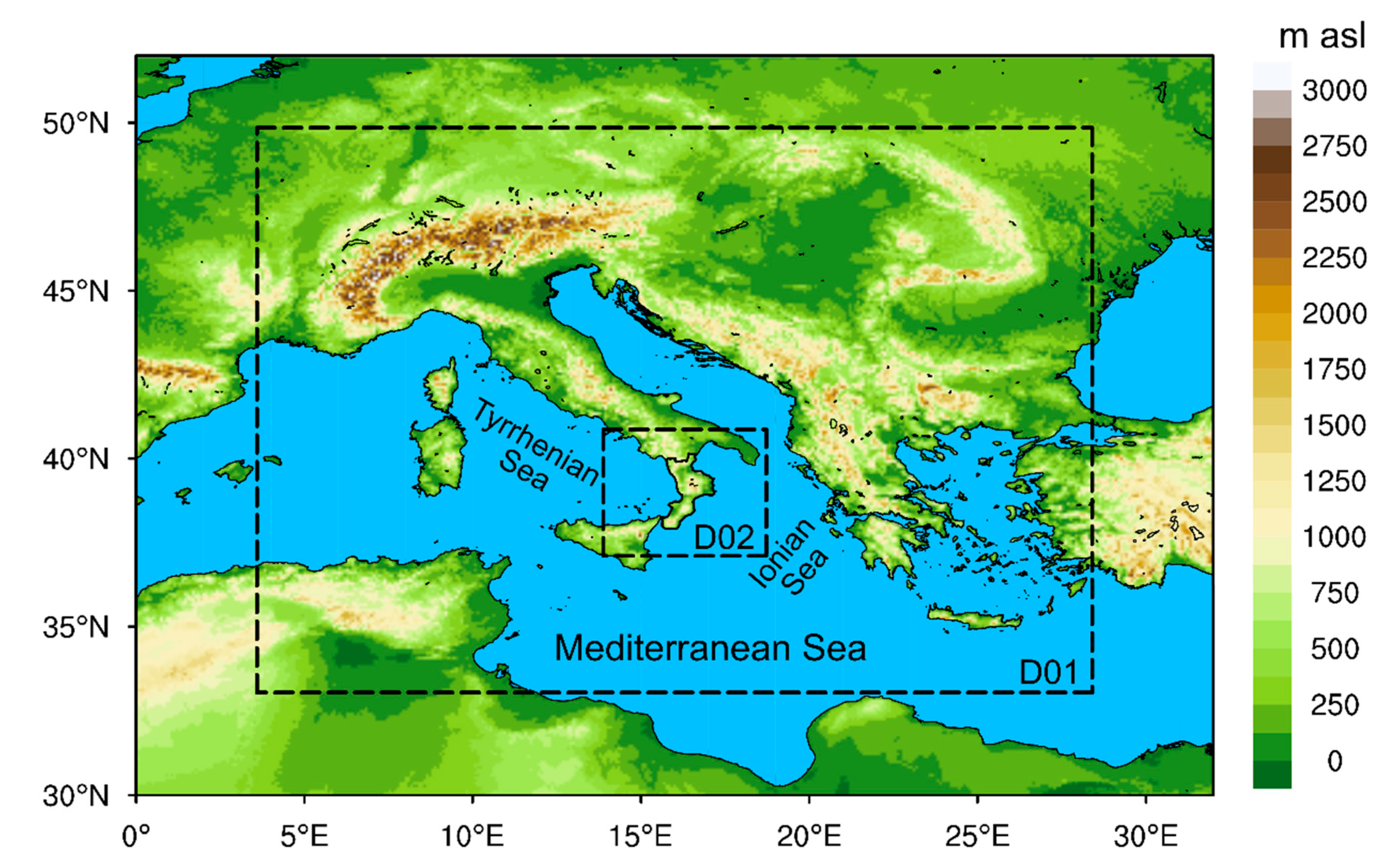


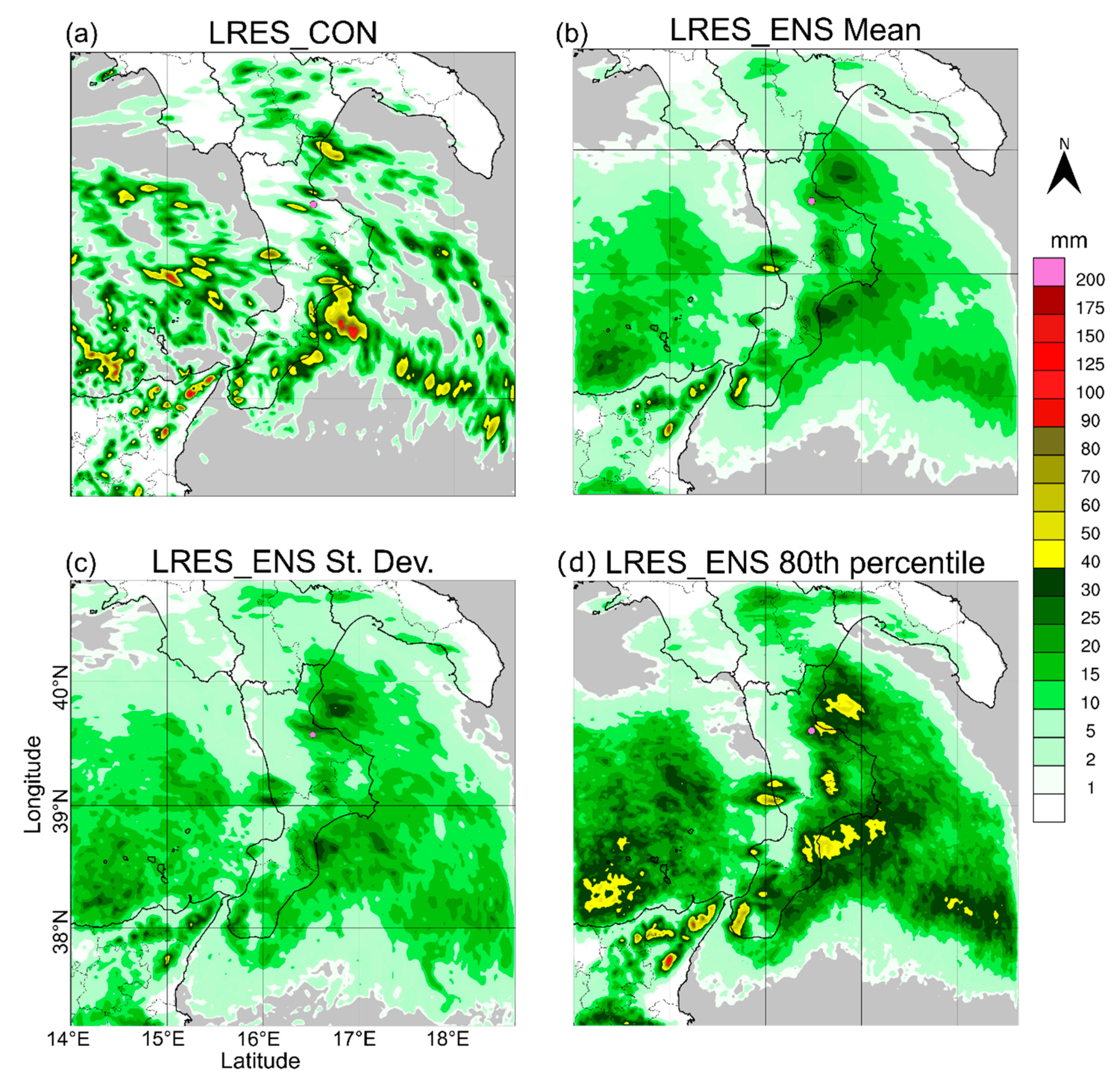
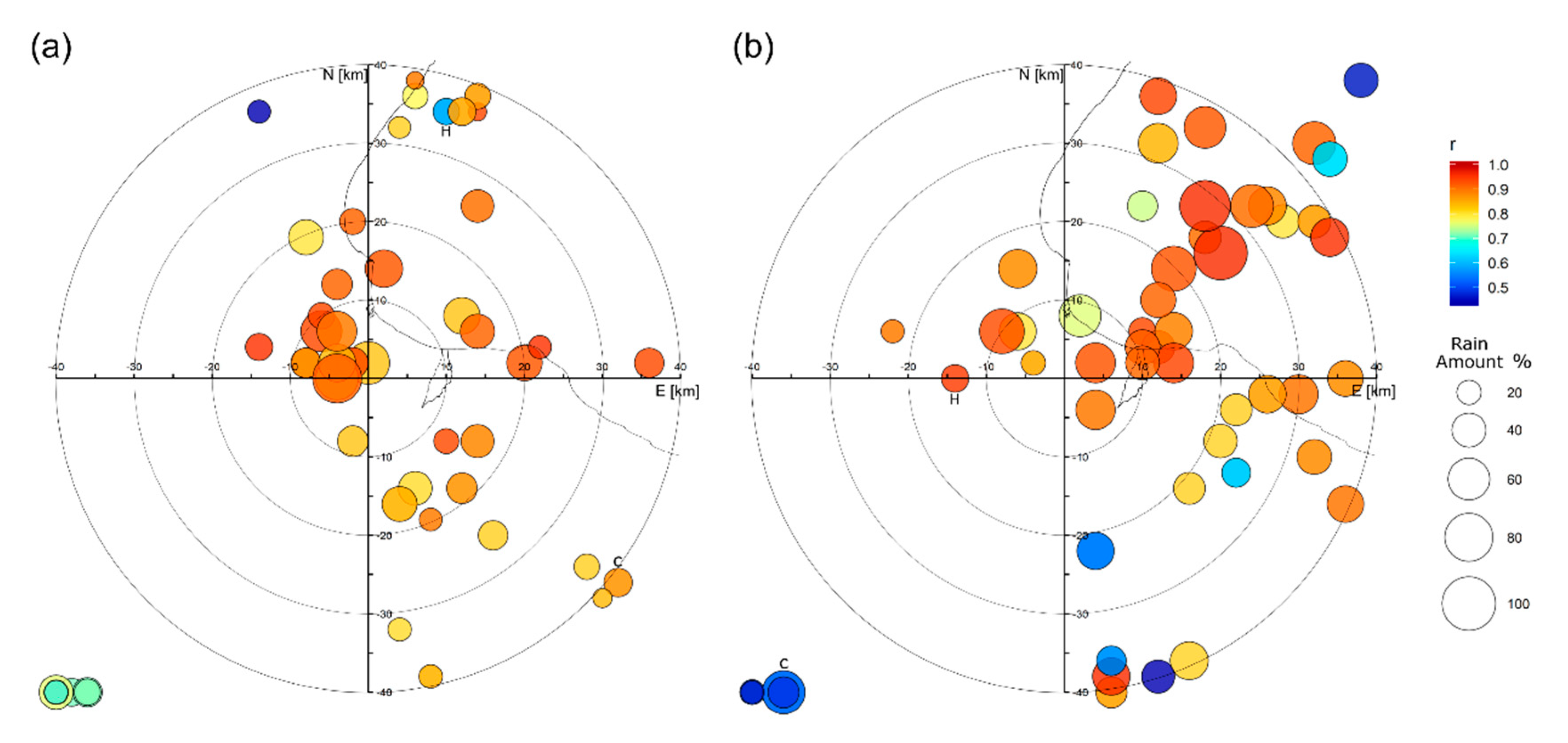
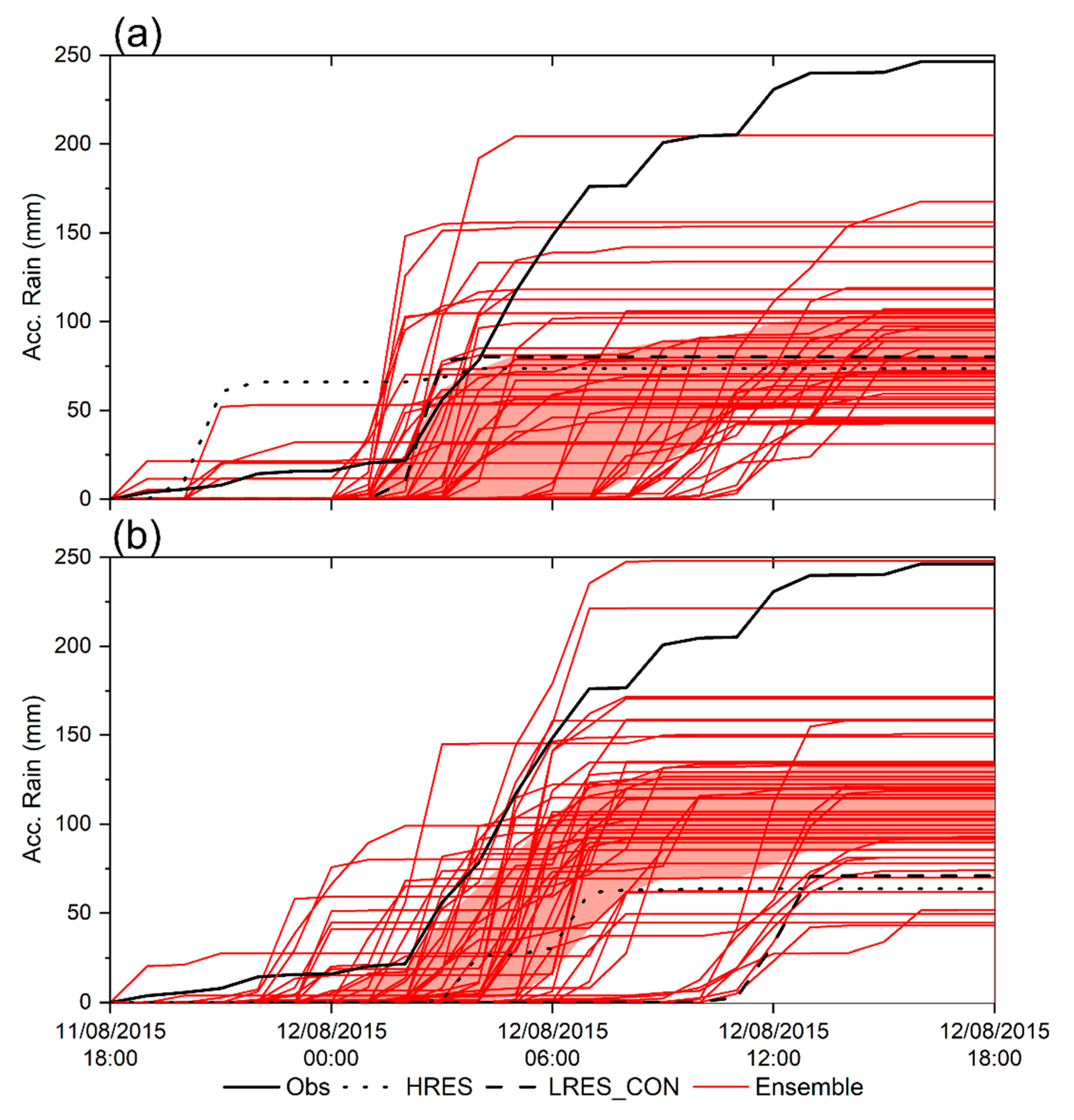
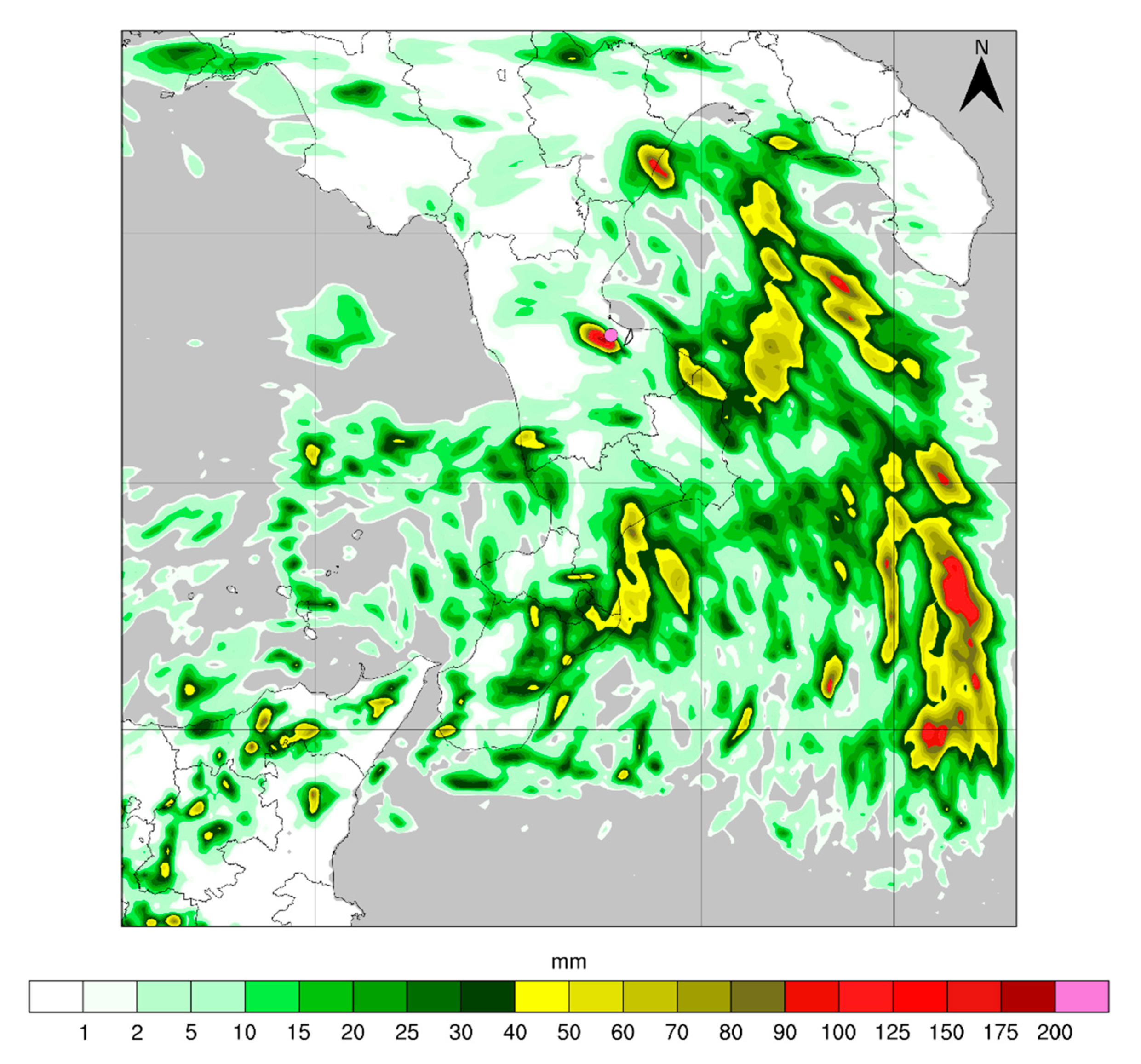
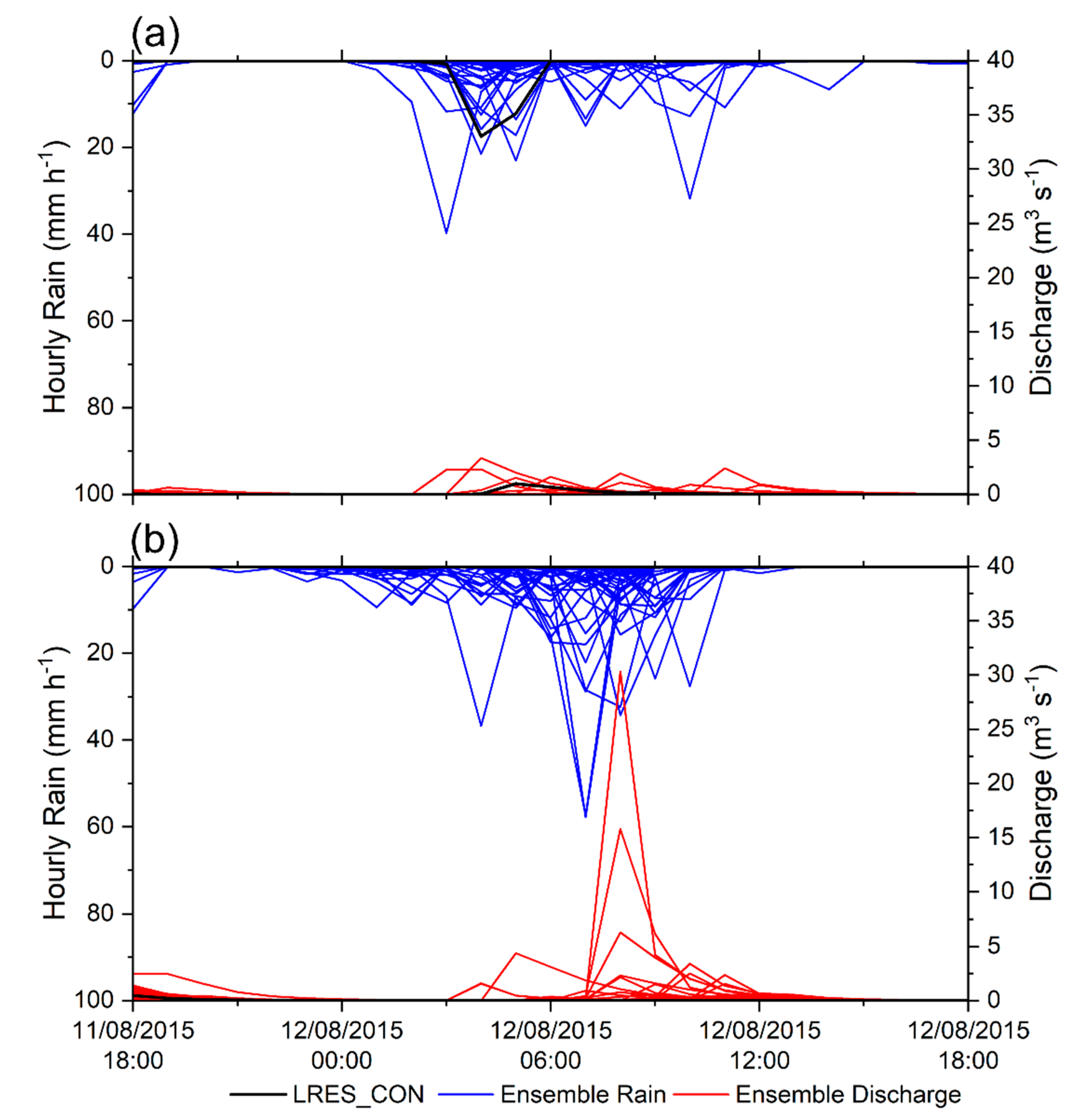
| WRF Physics Parameterization | |
| Component | Scheme |
| Microphysics | Lin-Purdue [41] |
| PBL | MJY [42] |
| Shortwave Radiation | Dudhia [43] |
| Longwave Radiation | RTTM [44] |
| Land Surface Model | Unified NOAH [45] |
| Surface Layer | Eta Similarity [46] |
| Cumulus | Kain-Fritsch (D01) [47] |
| WRF Domains Space and Time Resolutions | |
| D01 | 10 km (205 × 187 grid points), 60 s |
| D02 | 2 km (200 × 200 grid points), 12 s |
| Vertical layers | 44 terrain-following layers above the surface and 4 layers in the soil |
| WRF Initial and Boundary Conditions (ICs and BCs) | |
| GCM ICs and BCs | ECMWF-EPS, reference IFS Cycle 41r1 [48] |
| HRES: | High-resolution simulation at 16 km resolution |
| LRES_CON: | Ensemble control simulation at 32 km resolution |
| LRES_ENS: | 50 perturbations are applied to the initial conditions of the GCM, based on a multivariate Gaussian sampling technique [49] |
| Lower BCs (SST) | Native SST fields replaced with the Medspiration L4 Ultra-High Resolution SSTfnd product as a daily mean at a resolution of 0.022° [50,51]. The sst_update and the sst_skin [52] options were also activated, which permit dynamic SST and allow the system to simulate the daily SST cycle, respectively |
| WRF-Hydro Main Features | |
| Land Surface Model | Unified NOAH, 2 km resolution |
| Active modules | Subsurface, surface and channel water routing |
| Input from WRF | Precipitation and pressure on the ground, air temperature and humidity, wind speed and solar radiation (1 h time step) |
| Resolution | 200 m (2000 × 2000 grid points), disaggregation factor with respect to the atmospheric model of 1/10 |
| Initialization Time and Range of the Simulations | |
| 0000 UTC | 0000 UTC 11 August 2015 (48 h range) |
| 1200 UTC | 1200 UTC 11 August 2015 (36 h range) |
| Variable | ECMWF IFS | WRF | ||||
|---|---|---|---|---|---|---|
| HRES | LRES_CON | LRES_ENS | HRES | LRES_CON | LRES_ENS | |
| Starting time 11 August 2015 0000 UTC | ||||||
| Average accumulated precipitation in D02 | 9.3 | 8.5 | 10.6 ± 3.4 | 9.5 1 | 6.6 | 6.7 ± 2.0 |
| Rainfall peak near Corigliano | 22.9 | 27.4 | 31.0 ± 22.2 | 73.7 1 | 80.3 | 87.2 ± 35.4 |
| Starting time 11 August 2015 1200 UTC | ||||||
| Average accumulatedprecipitation in D02 | 12.7 | 12.1 | 12.0 ± 2.7 | 7.0 | 7.0 | 7.3 ± 1.1 |
| Rainfall peak near Corigliano | 39.3 | 35.1 | 41.4 ± 18.7 | 63.7 | 70.9 | 112.9 ± 40.0 |
© 2020 by the authors. Licensee MDPI, Basel, Switzerland. This article is an open access article distributed under the terms and conditions of the Creative Commons Attribution (CC BY) license (http://creativecommons.org/licenses/by/4.0/).
Share and Cite
Furnari, L.; Mendicino, G.; Senatore, A. Hydrometeorological Ensemble Forecast of a Highly Localized Convective Event in the Mediterranean. Water 2020, 12, 1545. https://doi.org/10.3390/w12061545
Furnari L, Mendicino G, Senatore A. Hydrometeorological Ensemble Forecast of a Highly Localized Convective Event in the Mediterranean. Water. 2020; 12(6):1545. https://doi.org/10.3390/w12061545
Chicago/Turabian StyleFurnari, Luca, Giuseppe Mendicino, and Alfonso Senatore. 2020. "Hydrometeorological Ensemble Forecast of a Highly Localized Convective Event in the Mediterranean" Water 12, no. 6: 1545. https://doi.org/10.3390/w12061545
APA StyleFurnari, L., Mendicino, G., & Senatore, A. (2020). Hydrometeorological Ensemble Forecast of a Highly Localized Convective Event in the Mediterranean. Water, 12(6), 1545. https://doi.org/10.3390/w12061545







